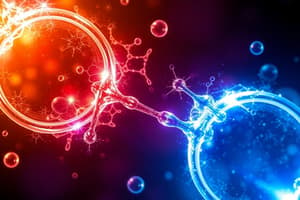Podcast
Questions and Answers
What is the primary characteristic of ionic bonding?
What is the primary characteristic of ionic bonding?
- Results in the formation of neutral atoms.
- Involves a transfer of electrons from one atom to another. (correct)
- Involves electron sharing between nonmetals.
- Occurs only between nonmetal atoms.
What contributes to the ductility of metals?
What contributes to the ductility of metals?
- The tightly held valence electrons.
- The strong ionic bonds between metal ions.
- The crystalline structure of metals.
- The presence of a sea of delocalized electrons. (correct)
Which of the following molecules is considered nonpolar?
Which of the following molecules is considered nonpolar?
- Sodium chloride (NaCl)
- Methane (CH4) (correct)
- Water (H2O)
- Hydrogen fluoride (HF)
Which factor is NOT relevant in determining the polarity of a molecule?
Which factor is NOT relevant in determining the polarity of a molecule?
What is a common feature of covalent bonds?
What is a common feature of covalent bonds?
What is the result of strong electrostatic forces in ionic bonding?
What is the result of strong electrostatic forces in ionic bonding?
Which type of bond is characterized by a partial positive and a partial negative charge across a molecule?
Which type of bond is characterized by a partial positive and a partial negative charge across a molecule?
What happens to the bond strength as the bond length increases?
What happens to the bond strength as the bond length increases?
Which example illustrates a polar molecule?
Which example illustrates a polar molecule?
What is the consequence of an electronegativity difference of 0.4 or greater in a bond?
What is the consequence of an electronegativity difference of 0.4 or greater in a bond?
Flashcards are hidden until you start studying
Study Notes
Chemical Bonding
Ionic Bonding
- Occurs between metals and non-metals.
- Involves transfer of electrons from one atom to another.
- Results in the formation of cations (positively charged ions) and anions (negatively charged ions).
- Strong electrostatic forces of attraction between oppositely charged ions.
- Typically forms crystalline structures (ionic crystals).
- Example: Sodium chloride (NaCl).
Metallic Bonding
- Occurs between metal atoms.
- Involves a 'sea of electrons' that are delocalized and free to move.
- Creates strong attractions between positively charged metal ions and the delocalized electrons.
- Contributes to properties such as electrical conductivity, malleability, and ductility.
- Example: Copper, aluminum.
Polarity In Molecules
- Determined by the arrangement of atoms and the difference in electronegativity between bonded atoms.
- Polar molecules have a partial positive charge on one side and a partial negative charge on the other.
- Nonpolar molecules have an even distribution of charge.
- Key factors for polarity:
- Electronegativity difference (≥ 0.4 indicates polar covalent bond).
- Molecular geometry (e.g., symmetry can cancel out dipoles).
- Example of polar molecule: Water (H2O).
- Example of nonpolar molecule: Methane (CH4).
Covalent Bonding
- Involves sharing of electron pairs between atoms.
- Occurs primarily between nonmetals.
- Can be single, double, or triple bonds depending on the number of shared electron pairs.
- Characterized by bond strength and length; shorter bonds are usually stronger.
- Molecules can be polar or nonpolar, depending on the electronegativity of the atoms involved.
- Example: Carbon dioxide (CO2) has double bonds, is linear, and nonpolar; water (H2O) has single bonds, bent shape, and is polar.
These bonding types form the basis for understanding molecular structure, reactivity, and properties of substances in chemistry.
Ionic Bonding
- Forms between metals and non-metals
- Results in the transfer of electrons
- Creates positively charged ions (cations) and negatively charged ions (anions)
- Strong electrostatic forces hold ions together
- Results in the formation of crystalline structures called ionic crystals
- Example: Sodium chloride (NaCl)
Metallic Bonding
- Occurs between metal atoms
- Electrons are delocalized and free to move, creating a 'sea of electrons'
- Strong attraction between positively charged metal ions and electrons
- Explains properties like electrical conductivity, malleability, and ductility
- Example: Copper and aluminum
Polarity in Molecules
- Determined by the arrangement of atoms and their electronegativity difference
- Polar molecules have uneven charge distribution with partial positive and negative ends
- Nonpolar molecules have an even distribution of charge
- Key factors for polarity:
- Electronegativity difference of at least 0.4 indicates a polar covalent bond
- Molecular geometry (symmetrical molecules can cancel out dipoles)
- Example of a polar molecule: Water (H2O)
- Example of a nonpolar molecule: Methane (CH4)
Covalent Bonding
- Involves sharing of electron pairs between atoms
- Occurs primarily between nonmetals
- Single, double, or triple bonds based on the number of shared electron pairs
- Bond strength and length are important: shorter bonds tend to be stronger
- Molecules can be polar or nonpolar, depending on the electronegativity of the atoms involved
- Example: Carbon dioxide (CO2) with double bonds is linear and nonpolar, while water (H2O) with single bonds is bent and polar
Studying That Suits You
Use AI to generate personalized quizzes and flashcards to suit your learning preferences.




